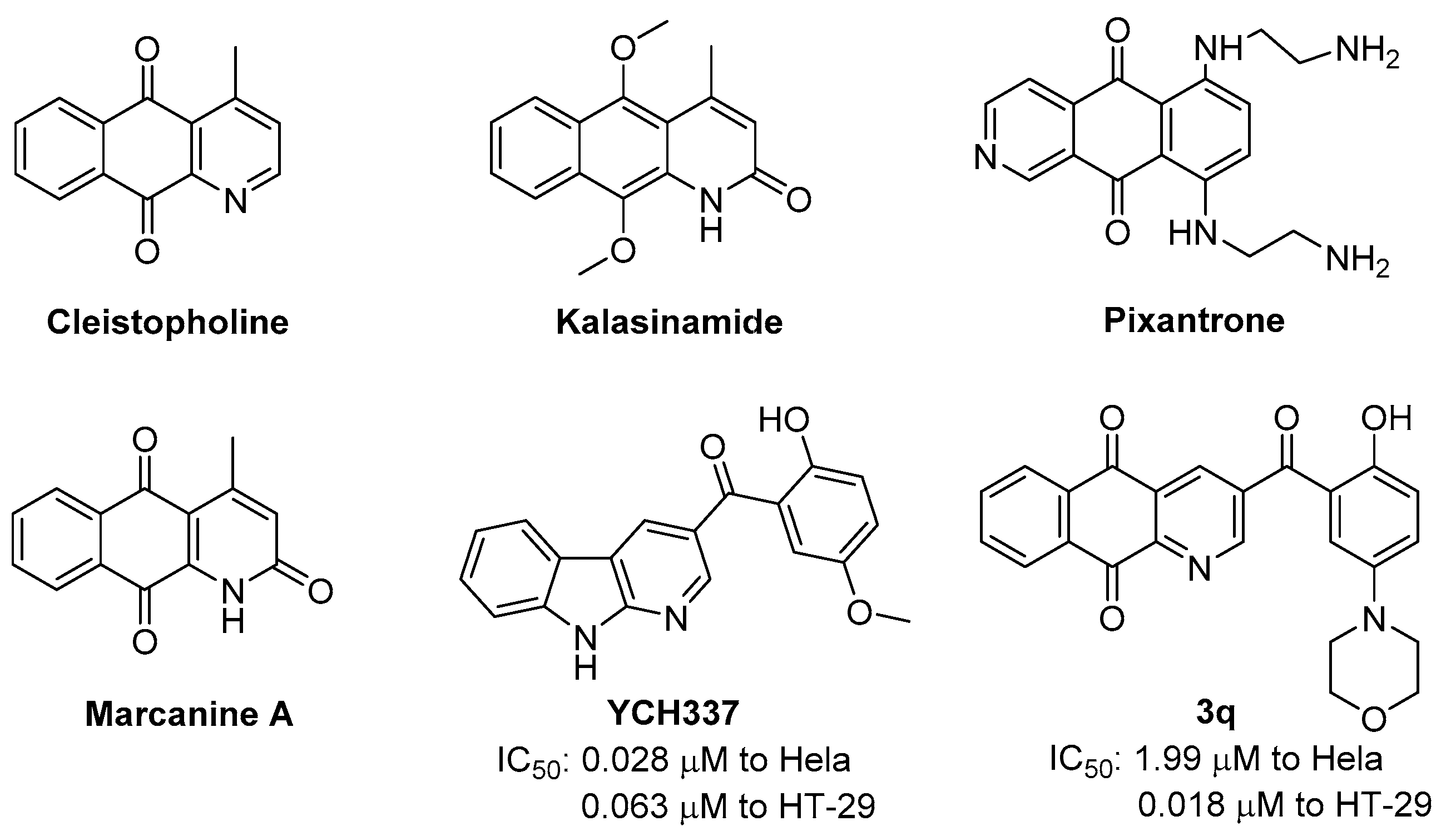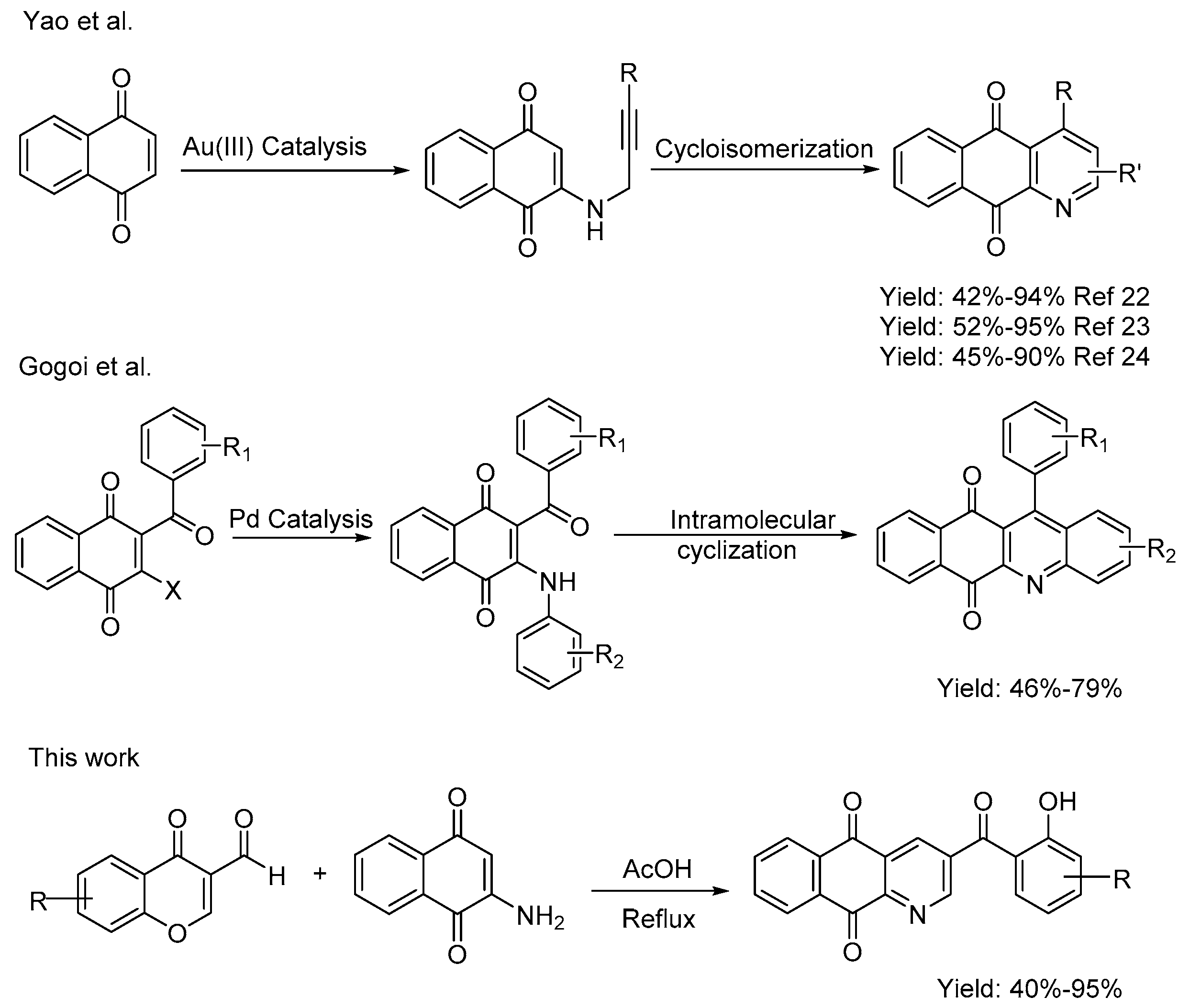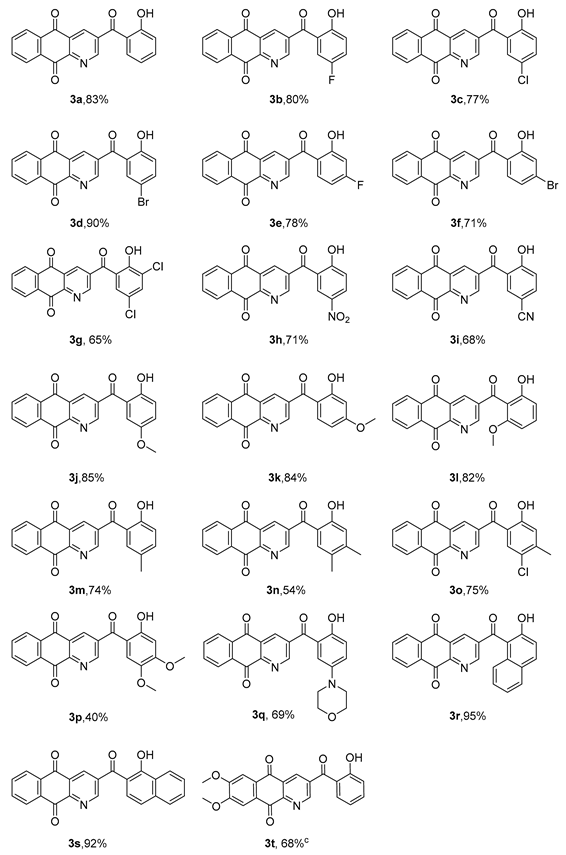One Pot and Metal-Free Approach to 3-(2-Hydroxybenzoyl)-1-aza-anthraquinones
Abstract
1. Introduction
2. Results and Discussion
3. Materials and Methods
3.1. General Information
3.2. Crystal Structure Determination of Compound 3t
3.3. General Procedure for the Synthesis of Compounds 1a–1t
3.4. General Procedure for 2-Amino-naphthalene-1,4-dione(2a)
3.5. General Procedure for the Synthesis of Compounds 3a–3t
4. Conclusions
Supplementary Materials
Author Contributions
Funding
Conflicts of Interest
References
- Huang, Q.; Lu, G.; Shen, H.-M.; Chung, M.C.M.; Ong, C.N. Anti-cancer properties of anthraquinones from rhubarb. Med. Res. Rev. 2007, 27, 609–630. [Google Scholar] [CrossRef] [PubMed]
- Hussain, H.; Al-Harrasi, A.; Al-Rawahi, A.; Green, I.R.; Csuk, R.; Ahmed, I.; Shah, A.; Abbas, G.; Rehman, N.U.; Ullah, R. A fruitful decade from 2005 to 2014 for anthraquinone patents. Expert Opin. Ther. Pat. 2015, 25, 1053–1064. [Google Scholar] [CrossRef] [PubMed]
- Devi Bala, B.; Muthusaravanan, S.; Perumal, S. An expedient synthesis of 1,2-dihydrobenzo[g]quinoline-5,10-diones via copper(II) triflate-catalyzed intramolecular cyclization of N-propargylaminonaphthoquinones. Tetrahedron Lett. 2013, 54, 3735–3739. [Google Scholar] [CrossRef]
- White, R.J.; Durr, F.E. Development of mitoxantrone. Investig. New Drugs 1985, 3, 85–93. [Google Scholar] [CrossRef]
- Weiss, R.B. The anthracyclines: Will we ever find a better doxorubicin? Semin. Oncol. 1992, 19, 670–686. [Google Scholar] [PubMed]
- Tan, C.; Tasaka, H.; Yu, K.-P.; Murphy, M.L.; Karnofsky, D.A. Daunomycin, an antitumor antibiotic, in the treatment of neoplastic disease. Clinical evaluation with special reference to childhood leukemia. Cancer 1967, 20, 333–353. [Google Scholar] [CrossRef]
- Claes, P.; Cappoen, D.; Mbala, B.M.; Jacobs, J.; Mertens, B.; Mathys, V.; Verschaeve, L.; Huygen, K.; De Kimpe, N. Synthesis and antimycobacterial activity of analogues of the bioactive natural products sampangine and cleistopholine. Eur. J. Med. Chem. 2013, 67, 98–110. [Google Scholar] [CrossRef] [PubMed]
- Gandy, M.N.; Piggott, M.J. Synthesis of Kalasinamide, a Putative Plant Defense Phototoxin. J. Nat. Prod. 2008, 71, 866–868. [Google Scholar] [CrossRef] [PubMed]
- Cavalletti, E.; Crippa, L.; Mainardi, P.; Oggioni, N.; Cavagnoli, R.; Bellini, O.; Sala, F. Pixantrone (BBR 2778) has reduced cardiotoxic potential in mice pretreated with doxorubicin: Comparative studies against doxorubicin and mitoxantrone. Investig. New Drugs 2007, 25, 187–195. [Google Scholar] [CrossRef]
- Soonthornchareonnon, N.; Suwanborirux, K.; Bavovada, R.; Patarapanich, C.; Cassady, J.M. New Cytotoxic 1-Azaanthraquinones and 3-Aminonaphthoquinone from the Stem Bark of Goniothalamus marcanii. J. Nat. Prod. 1999, 62, 1390–1394. [Google Scholar] [CrossRef]
- Lang, S.; Groth, U. Total syntheses of cytotoxic, naturally occurring kalasinamide, geovanine, and marcanine A. Angew. Chem. 2009, 48, 911–913. [Google Scholar] [CrossRef] [PubMed]
- Tuchinda, P.; Pohmakotr, M.; Munyoo, B.; Reutrakul, V.; Santisuk, T. An azaanthracene alkaloid from Polyalthia suberosa. Phytochemistry 2000, 53, 1079–1082. [Google Scholar] [CrossRef]
- Mekideche, S.; Désaubry, L. Tandem Diels–Alder-manganese dioxide mediated oxidation reaction. A short route to marcanines. Tetrahedron Lett. 2008, 49, 5268–5270. [Google Scholar] [CrossRef]
- Potts, k.T.; Bhattacharjee, D.; Walsh, E.B. Cycloaddition routes to azaanthraquinone derivatives. 1. Use of azadienophiles. J. Org. Chem. 1986, 51, 2011–2021. [Google Scholar] [CrossRef]
- Catti, F.; Kiuru, P.S.; Slawin, A.M.; Westwood, N.J. The synthesis of highly functionalised pyridines using Ghosez-type reactions of dihydropyrazoles. Tetrahedron 2008, 64, 9561–9566. [Google Scholar] [CrossRef] [PubMed][Green Version]
- Rathelot, P.; Rémusat, V.; Vanelle, P. Synthesis of 3-Alkenyl-1-azaanthraquinones via Diels-Alder and Electron Transfer Reactions. Molecules 2002, 7, 917–921. [Google Scholar] [CrossRef]
- Krapcho, A.P.; Landi, J.J.; Hacker, M.P.; McCormack, J.J. Synthesis and antineoplastic evaluations of 5,8-bis[(aminoalkyl)amino]-1-azaanthracene-9,10-diones. J. Med. Chem. 1985, 28, 1124–1126. [Google Scholar] [CrossRef]
- Boger, D.L.; Hong, J.; Hikota, M.; Ishida, M. Total Synthesis of Phomazarin. J. Am. Chem. Soc. 1999, 121, 2471–2477. [Google Scholar] [CrossRef]
- Tapia, R.A.; Venegas, J.; Cantuarias, L.B. Copper Bromide–Catalyzed C-Alkylation of 2-Amino-1,4-Naphthoquinone: New Synthesis of 1-Azaanthraquinones. Synthetic Commun. 2009, 40, 151–156. [Google Scholar] [CrossRef]
- Cuerva, J.M.; Cárdenas, D.J.; Echavarren, A.M. Intramolecular Michael-type addition of azadienes to 1,4-naphthoquinones instead of Aza-Diels–Alder cycloaddition: A synthesis of ascididemin. J. Chem. Soc. Perk. T. 1 2002, 11, 1360–1365. [Google Scholar] [CrossRef]
- Chuang, C.-P.; Tsai, P.-J.; Kao, C.-B.; Chiow, W.-R. Manganese(III) Acetate Mediated Oxidative Radical Cyclizations of N-(2-Alkenylaryl)-Substituted Enamines. Synthesis 2013, 46, 175–182. [Google Scholar] [CrossRef][Green Version]
- Fei, N.; Yin, H.; Wang, S.; Wang, H.; Yao, Z.-J. CuCl2-Promoted 6-endo-dig Chlorocyclization and Oxidative Aromatization Cascade: Efficient Construction of 1-Azaanthraquinones from N-Propargylaminoquinones. Org. Lett. 2011, 13, 4208–4211. [Google Scholar] [CrossRef] [PubMed]
- Jiang, C.; Xu, M.; Wang, S.; Wang, H.; Yao, Z.J. Azaanthraquinone assembly from N-propargylamino quinone via a Au(I)-catalyzed 6-endo-dig cycloisomerization. J. Org. Chem. 2010, 75, 4323–4325. [Google Scholar] [CrossRef] [PubMed]
- Fei, N.; Hou, Q.; Wang, S.; Wang, H.; Yao, Z.J. Azaanthraquinone assembly from N-propargylamino quinone via iodine-induced 6-endo-dig electrophilic cyclization. Org. Biomol. Chem. 2010, 8, 4096–4103. [Google Scholar] [CrossRef]
- Borah, A.; Sharma, A.; Hazarika, H.; Sharma, K.; Gogoi, P. Synthesis of 1-Azaanthraquinone: Sequential C–N Bond Formation/Lewis Acid Catalyzed Intramolecular Cyclization Strategy. J. Org. Chem. 2017, 82, 8309–8316. [Google Scholar] [CrossRef] [PubMed]
- Xiang, H.; Chen, J.; Miao, Z.; Yang, C. Cascade synthesis of novel functionalized pyridine-fused coumarins in aqueous medium. RSC Adv. 2014, 4, 16132–16135. [Google Scholar] [CrossRef]
- Zhang, X.; He, Q.; Xiang, H.; Song, S.; Miao, Z.; Yang, C. Rapid access to α-carbolines via a one-pot tandem reaction of α,β-unsaturated ketones with 2-nitrophenylacetonitrile and the anti-proliferative activities of the products. Org. Biomol. Chem. 2014, 12, 355–361. [Google Scholar] [CrossRef] [PubMed]
- Qi, X.; Xiang, H.; He, Q.; Yang, C. Synthesis of Multisubstituted 2-Aminopyrroles/pyridines via Chemoselective Michael Addition/Intramolecular Cyclization Reaction. Org. Lett. 2014, 16, 4186–4189. [Google Scholar] [CrossRef]
- Dai, T.; Li, Q.; Zhang, X.; Yang, C. Substituent-Oriented Synthesis of Substituted Pyrazoles/Chromeno[3,2-c]pyrazoles via Sequential Reactions of Chromones/3-Chlorochromones and Tosylhydrazones. J. Org. Chem. 2019, 84, 5913–5921. [Google Scholar] [CrossRef]
- Peng, X.; Zhang, X.; Li, S.; Lu, Y.; Lan, L.; Yang, C. Silver-mediated synthesis of novel 3-CF3/CN/phosphonate-substituted pyrazoles as pyrrolomycin analogues from 3-formylchromones and diazo compounds. Org. Chem. Front. 2019, 6, 1775–1779. [Google Scholar] [CrossRef]
- Qi, X.; Xiang, H.; Yang, C. Synthesis of Functionalized Chromeno[2,3-b]pyrrol-4(1H)-ones by Silver-Catalyzed Cascade Reactions of Chromones/Thiochromones and Isocyanoacetates. Org. Lett. 2015, 17, 5590–5593. [Google Scholar] [CrossRef] [PubMed]
- Yi, J.M.; Zhang, X.F.; Huan, X.J.; Song, S.S.; Wang, W.; Tian, Q.T.; Sun, Y.M.; Chen, Y.; Ding, J.; Wang, Y.Q.; et al. Dual Targeting of Microtubule and Topoisomerase II by α-Carboline Derivative YCH337 for Tumor Proliferation and Growth Inhibition. Oncotarget 2015, 6, 8960–8973. [Google Scholar] [CrossRef] [PubMed]
- Zhang, C.H.; Huang, R.; Hu, X.M.; Lin, J.; Yan, S.J. Three-Component Site-Selective Synthesis of Highly Substituted 5 H-Chromeno-[4,3-b]pyridines. J. Org. Chem. 2018, 83, 4981–4989. [Google Scholar] [CrossRef] [PubMed]
- Lacova, M.; Puchala, A.; Solcanyova, E.; Lac, J.; Kois, P.; Chovancova, J.; Rasala, D. 3-Formylchromones IV. The Rearrangement of 3-Formylchromone Enamines as a Simple, Facile Route to Novel Pyrazolo[3,4-b]pyridines and the Synthetic Utility of the Latter. Molecules 2005, 10, 809–821. [Google Scholar] [CrossRef] [PubMed]
- Iaroshenko, V.O.; Mkrtchyan, S.; Volochnyuk, D.M.; Langer, P.; Sosnovskikh, V.Y.; Ostrovskyi, D.; Dudkin, S.; Kotljarov, A.V.; Miliutina, M.; Savych, I.; et al. 3-Formylchromones, Acylpyruvates, and Chalcone as Valuable Substrates for the Syntheses of Fused Pyridines. Synthesis 2010, 2010, 2749–2758. [Google Scholar] [CrossRef]
- Quiroga, J.; Mejía, D.; Insuasty, B.; Abonía, R.; Nogueras, M.; Sánchez, A.; Cobo, J.; Low, J.N. Synthesis of 6-(2-hydroxybenzoyl)pyrazolo[1,5-a]pyrimidines by reaction of 5-amino-1h-pyrazoles and 3-formylchromone. J. Heterocyclic Chem. 2002, 39, 51–54. [Google Scholar] [CrossRef]
- Bari, A. A Facile Route to Synthesize 1,2-Dihydropyridine and 1,6 Pyrimidinone Analogues from 4-Oxo-4H-Chromene-3-Carbaldehyde. J. Heterocyclic Chem. 2016, 53, 461–466. [Google Scholar] [CrossRef]
- Haas, G.; Stanton, J.L.; Von Sprecher, A.; Wenk, P. The synthesis of pyridine derivatives from 3-formylchromone. J. Heterocyclic Chem. 1981, 18, 607–612. [Google Scholar] [CrossRef]
Sample Availability: Samples of the compounds 1a–1t and 3a–3t are available from the authors. |





| Entry | Ratio (2a:1a) | Solvent | Temp (°C) | Time (h) | Yield b (%) |
|---|---|---|---|---|---|
| 1 | 1:1.1 | AcOH | 80 | 24 | 35 |
| 2 | 1:1.1 | AcOH | 100 | 19 | 67 |
| 3 | 1:1.1 | AcOH | Reflux | 4 | 76 |
| 4 | 1:1.1 | DMF | 120 | 24 | n.d. c |
| 5 | 1:1.1 | DMSO | 120 | 24 | 32 |
| 6 | 1:1.1 | Propionic acid | 120 | 19 | 70 |
| 7 | 1:1.1 | 1,4-dioxane | Reflux | 24 | n.d. c |
| 8 | 1:1.1 | AcOH:Et3N (1:1) | 100 | 24 | 48 |
| 9 | 1:1 | AcOH | Reflux | 4 | 71 |
| 10 | 1:1.2 | AcOH | Reflux | 4 | 83 |
| 11 | 1:1.3 | AcOH | Reflux | 4 | 70 |
| 12 | 1:1.5 | AcOH | Reflux | 4 | 77 |
 |
 |
| Compd | IC50 [μM] b,c | |
|---|---|---|
| Hela | HT-29 | |
| 3q | 1.99 | 0.018 |
| 3p | 4.69 | 2.26 |
| 3j | 7.98 | 4.15 |
| 3n | - | 4.41 |
| 3l | 12.81 | 1.27 |
| CA-4 | 0.78 (nM) | 0.74 |
| YCH337 | 0.028 | 0.063 |
© 2019 by the authors. Licensee MDPI, Basel, Switzerland. This article is an open access article distributed under the terms and conditions of the Creative Commons Attribution (CC BY) license (http://creativecommons.org/licenses/by/4.0/).
Share and Cite
Yuan, J.; He, Q.; Song, S.; Zhang, X.; Miao, Z.; Yang, C. One Pot and Metal-Free Approach to 3-(2-Hydroxybenzoyl)-1-aza-anthraquinones. Molecules 2019, 24, 3017. https://doi.org/10.3390/molecules24163017
Yuan J, He Q, Song S, Zhang X, Miao Z, Yang C. One Pot and Metal-Free Approach to 3-(2-Hydroxybenzoyl)-1-aza-anthraquinones. Molecules. 2019; 24(16):3017. https://doi.org/10.3390/molecules24163017
Chicago/Turabian StyleYuan, Jiaqi, Qian He, Shanshan Song, Xiaofei Zhang, Zehong Miao, and Chunhao Yang. 2019. "One Pot and Metal-Free Approach to 3-(2-Hydroxybenzoyl)-1-aza-anthraquinones" Molecules 24, no. 16: 3017. https://doi.org/10.3390/molecules24163017
APA StyleYuan, J., He, Q., Song, S., Zhang, X., Miao, Z., & Yang, C. (2019). One Pot and Metal-Free Approach to 3-(2-Hydroxybenzoyl)-1-aza-anthraquinones. Molecules, 24(16), 3017. https://doi.org/10.3390/molecules24163017







